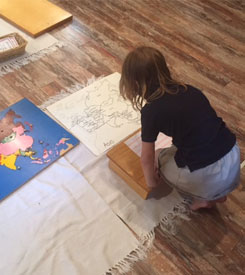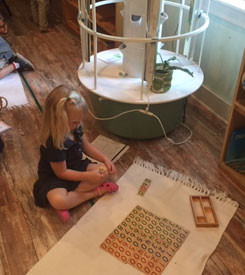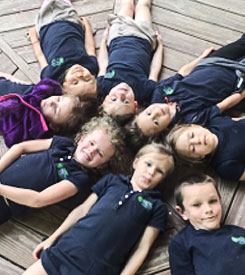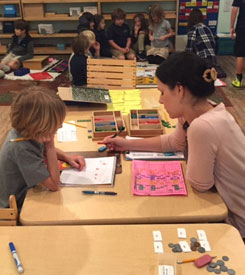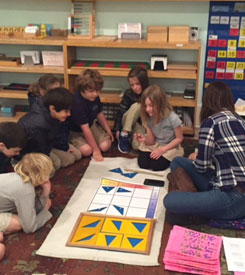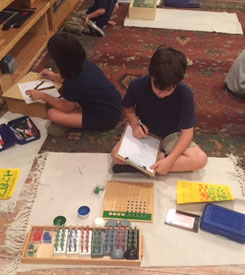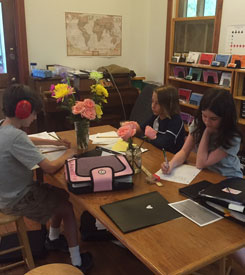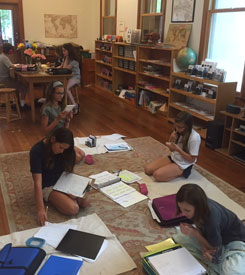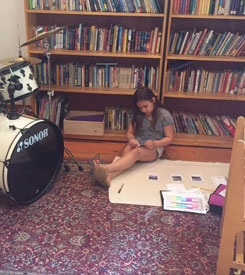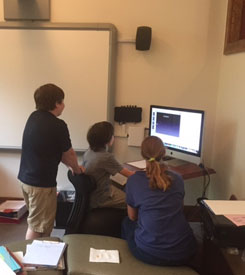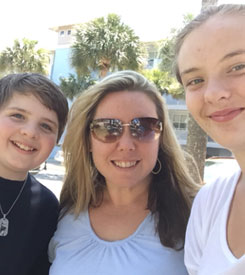SWMA Day to Day Schedule / Curriculum
Daily Schedule:
The morning is valuable working and learning time for each child and consistency and timeliness are necessary for an optimal academic experience. Drop off is between 8 and 8:20AM. Please stay in your car and a staff member will help your child get out. If your child must arrive late for school, please bring your child to the office to sign them in and receive a late slip. A staff member will walk your child to their classroom after they have been signed in. Often times with younger students, this change in routine can upset them, and might throw off their day. We appreciate your daily effort to arrive on time.
Toddler Program:
Our Toddler Program introduces children to the Montessori classroom; an environment created to nurture the individual. Ages 18mos to 3yrs. In the prepared environment, children access experiential based learning materials that leave concrete impressions and create a foundation for the development of language, mathematics and cultural awareness. Young learners develop motor skills necessary for independence, care of oneself, and care of the environment.
Recognizing that the toddler years are one of the most beautiful and delicate phases in the young child’s development, we encourage independence while supporting social and emotional growth. We teach peaceful conflict resolution, with the hope of creating a foundation of confidence and the value of cherishing all living things.
The Montessori Philosophy to “follow the child” allows us to find teachable moments through emerging curriculum. The South Walton Montessori Toddler Program is a loving environment for a toddler to experience liberty of choice within a daily structure that will ultimately prepare the individual for a Montessori Preschool education.
Toddler Daily Schedule
8-8:20: Drop Off
8-9:30ish: Playground, Snack, and Diaper Work
9:30-10:45: Morning Work Cycle and Diaper Work
10:45-11:00: Circle Time
11:00-11:30: Lunch
11:30-12: Diaper work
12:00-2: Nap
2-2:30: Diaper work
2:30: Dismissal
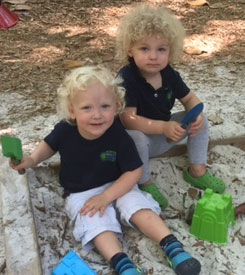
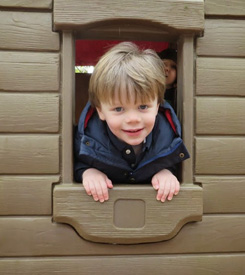
Primary Program:
The Montessori Primary is a three to four year program of child development. It is individualized because no two children grow in exactly the same way. There are five areas of the curriculum:
PRACTICAL LIFE – Work in this area develops concentration, order, coordination, and independence.
SENSORIAL – The sensorial materials enable the Primary child to clarify, classify, and comprehend his/her world.
MATHEMATICS – The child builds the foundation for mathematical concepts through manipulation and experimentation with Montessori mathematics materials.
LANGUAGE – The child learns language phonetically using concrete materials that include sandpaper letters, object boxes, and moveable alphabets. Reading and writing develop simultaneously as the child “strings sounds” together to make words.
CULTURAL SUBJECTS – Key concepts for physical and cultural geography are learned with the use of continent puzzle maps which the child traces while hearing the name of the country. Biology, Botany, Zoology and Geology are learned through the classification of cards and manipulation of puzzles designed to interest the child in the study of science.
Typically, the three-year-old gives much attention to the Practical Life and Sensorial areas, gaining skills that later are applied in the learning of Mathematics, Language, and Cultural Subjects. In Montessori, the four- and five-year old experiences a time of rapid, self-directed progress in Reading, Writing, and Mathematics.
Our program begins with the understanding that children have a natural instinct to learn. The Primary years are known as the time of the absorbent mind, a time of peak receptivity. This receptivity is periodic in nature and is selective as to forms or styles of learning. The Montessori Method is a scientific study of these changes in receptivity, resulting in an exceptionally effective program.
Children in the Primary class learn through hands-on use of materials, carefully designed for a wide range of needs, interests and abilities. The teacher, as keen observer and guide, directs the child to a material that is right for the individual at that moment in development and gives a lesson on how to use it. The child may use the material again and again until the lesson is fully absorbed, at which time the teacher will introduce the material that comes next. The classroom is fully equipped with materials designed by Maria Montessori for use at each level. Materials are of the highest quality and made according to the guidelines set by the American Montessori Society.
The Primary classroom is designed for the child. Students may work at child-size tables and chairs or on work rugs. The work is individualized, each child choosing the specific task he/she needs to help explore and define the world. There is also daily work on socialization, when children learn to work in a group, to be considerate of classmates and adults, and to be polite toward each other.
Curriculum
MATHEMATICS – Classification, quantification, patterning, comparing; linear counting, skip-counting; decimal system concepts, adding, subtracting, multiplying, dividing with concrete decimal system material, exchange (carry and borrow); math fact practice, introduction to fractions.
GEOMETRY – Discrimination of shape; experience with basic plane and solid shapes and their names; sensorial concepts of length, weight, volume; introduction to polygons; study of triangles.
READING – Auditory , visual and symbolic development; phonics beginning with consonant and vowel sounds and continuing with blends, digraphs, phonograms; sight words, phrase and sentence building; use of phonetic readers with increasing comprehension; reading aloud.
LANGUAGE – Use of the materials for visual and auditory discrimination; vocabulary through labeling; three-period lessons for learning nomenclature; song, poetry , recitation, listening to stories, sharing, vocabulary of grace and courtesy, role-playing.
GRAMMAR – Introduction to parts of speech through use of the Montessori farm and through use of the solid symbols for parts of speech.
WRITING AND SPELLING – Fine motor preparation exercises; spelling with the moveable alphabet; printing, phrase and sentence composition.
RESEARCH – Adult guidance to child’s expressed areas of interest; various forms of work in those areas; introduction to alphabetization; research and booklets on many areas of cultural study including needs of people, botany, zoology , and geography puzzle maps.
LITERATURE – Reading for comprehension; oral story telling; poetry; discussion of author and illustrator
SCIENCE – Living/non-living; parts of plants and animals; classification of living things (mammal, etc.); habitat; experiments in the needs of living things; care of classroom plants; sink/float; magnets; balance; magnification; classification of rocks.
GEOGRAPHY – Parts of the Earth; continents; countries of the continents; physical geography nomenclature; land and water forms; relationship of geography to needs of people; study of flags.
HISTORY – Timeline of one day; birthday celebration including walking the Earth around the Sun; seasons; personal timeline in pictures and words; early life forms; days, months, holidays, calendar formation; clock study.
PRACTICAL LIFE – Grace and courtesy in all areas of movement and work; grasping, sorting, pairing, cleaning, spooning, crushing, tonguing, tweezing, eye-dropping, dressing, grinding, sweeping, washing, cutting, pouring and other similar activities; care of self; care of the environment.
SENSORIAL DEVELOPMENT – Refinement of senses of color, form, mass, tone, texture, smell, temperature, length and taste through specific exercises of comparison and classification.
SOCIAL SKILLS – Independent activity in a dynamic environment; manners and courtesy in groups; inner discipline through independent activity; conflict resolution processes; respect for the activity and work of others; courteous wording; encouragement of stating one’s needs; care for others as a natural development of curriculum and process.
INDEPENDENCE – Use of space-defining mats and rugs for work; learning to make good work choices; learning to make good behavior choices; teacher respect for child’s choices; flexible curriculum and rate of development; education of the will through various forms of feedback; joy in self -chosen activity.
SERVICE – Preparing and serving snack to classmates.
PHYSICAL DEVELOPMENT – Activities in body-image awareness; practice in graceful movement; balance activities; engaging in practical living and sensorial exercises or works; dance; nutritious snacks and lunches; adequate time for outdoor play.
ARTS – Use of crayons, oil pastels, charcoal, pencils, pens, fabric, cutting, weaving, color mixing, clay and other media (usually set up); easel work as desired; stories of great artists; study of well-known artists; listening to excellent music, study of musicians; introduction to drama through emulation, acting out words, sentences and feelings; study of musical scale with bells.
Primary Daily Schedule
8-8:20: Drop Off
8-11: Morning Work Cycle (Snack any time throughout the morning)
11:00-11:30: Lunch
11:30-12:45: Playground
1:00: Circle
1:15-2:30: Nap/ Rest your body
2:45: Dismissal
Lower Elementary Program:
At around age six, a change occurs in the child that gives us a key to the elementary years. The child develops the mental power to visualize and explore, which has not been experienced first-hand. We call this the ability to abstract. This new ability opens vast new arenas for learning. The elementary child is able to learn about anything that can be held in the intellect, including the entire world and the universe. Accordingly, Montessori provides the elementary-age child with large and noble themes.
Science and History lessons are presented in a group, and are followed by individual work and research. Topics include the history of our universe, the timeline of life on earth, and global geography.
All work is individualized according to the child’s foundation. Challenges offered are attainable, yet compelling enough to engage the child toward deeper interest.
Reading, developed phonetically, advances steadily through a guided progression of spelling, writing, dictation, and workshops.
Mathematics moves from the concrete level towards abstraction through daily practice with the advanced Montessori Materials. These materials define the early areas of geometry, algebra and calculus.
Curriculum
MATHEMATICS – Skip-counting; operations of addition, subtraction, multiplication and division with large numbers; math facts using a variety of methods; word problems; drill to abstraction; fractions; equivalence; time; money; linear measurement; factors, multiples; rounding, estimation; weight, temperature; simple graphs; inequalities.
GEOMETRY – Learning nomenclature; formation of geometric shapes; measurement of perimeter; measurement of angles; study of lines, polygons, circles, solids; congruence; use of compass and ruler.
READING – Study of blends, digraphs, phonograms, sight words; reading for comprehension; cause and effect, plot inference, main idea; character traits; reading selections from short stories, poems, folk tales, mythology, chapter books, reference materials.
LANGUAGE – Logical expression; functions of words (grammar); parts of a sentence; punctuation; abbreviations; capitalization; alphabetizing; study of synonyms, antonyms, rhyming words, compound words, suffixes, contractions, associations; dictionary and thesaurus use.
GRAMMAR – Study, analysis and labeling of noun, article, adjective, verb, preposition, adverb, pronoun, conjunction and interjection; use of sentence analysis charts to analyze and construct simple compound and complex sentences and identify parts of sentences.
WRITING AND SPELLING – Handwriting: cursive; creative writing of stories and poems; study of elements of a story; writing using children’s literature; letter writing; spelling.
LITERATURE – oral reading of children’s literature; discussion of plot, sequence, cause-effect, setting, character; book projects, study of poets; writing based on literature; story telling; silent reading.
SCIENCE – Study of the universe, stars, solar system, Sun, Moon; study of atoms and molecules, states of matter; laws of physics; heat, light, electricity; magnetism; sound; earth science, geology, weather; classification in botany and zoology; experimental science, anatomy, health.
GEOGRAPHY – Oceans, continents, countries; land and water forms; interior of the Earth, study of volcanoes; resources, needs of people.
HISTORY – Study of the calendar, clock, seasons; time line of natural history; study of geological eras; study of early people; needs of people throughout history; myths.
PRACTICAL LIVING – Care of classroom, including plants, using tools; care of outdoors; care of self.
SOCIAL SKILLS – Exercises in grace and courtesy; role playing; class meetings with lessons and experiences in problem-solving skills.
INDEPENDENCE – Weekly work plans agreed on each week; individual choices of topic for research and special projects.
SERVICE – Opportunities to help others in the classroom as a daily occurrence; weekly responsibilities help maintain indoor and outdoor environments;
PHYSICAL DEVELOPMENT – Organized physical education activity each week; outdoor play 45 minutes to one hour each day; management of large muscle movement in the classroom so as not to disturb activities of others.
DRAMA –Drama teaches self-confidence, teamwork, responsibility and independence. Lower Elementary Class produces and stars in two performances each year- one at the Holiday Performance and one at the Spring Fling.
ARTS – Study of great artists and composers; experience with art media; Music and Pictures; botanical and zoological illustrations; schools of art; art connected to geography, math, language, history; fractals.
Lower Elementary Schedule
8-8:20: Drop Off
8:20: Community Meeting
8:45-12: Work Cycle
12:00: Early Lunch for students with completed work plan
12:30: Lunch / Playground
1:30-2:30: Afternoon Special Classes: Music, Science, Spanish, History, Art
2:30: Restore Environment/Reading
3:00: Dismissal
Upper Elementary Program:
The Upper Elementary Classroom, for children age’s nine to twelve, builds on the lower elementary experience. This is an exciting time for students as the curriculum becomes increasingly sophisticated and challenging, yet still allows them to refine basic skills and learn how to manage their time.
Students become more independent and proficient as they begin in-depth research and study for individual and group projects. In UE, students are working towards the abstract. Montessori materials are still available, and new subjects such as advanced science, creative writing, economics, literature and social and emotional development are added to the core curriculum.
Curriculum
MATHEMATICS – Abstract solution of problems involving the four basic operations; final memorization of math facts; metrics and English measurement; negative numbers; advanced fractions operations involving common multiples and factors; inequalities; ratios, proportion; decimal notation, equivalence of fractions / decimals / percents ; operations with fractions, decimals/percents.
GEOMETRY – Areas of plane figures; volume of solids; classical Euclidean constructions using a compass and straight edge, construction of model solids, nomenclature of angles, nomenclature of lines, nomenclature of plane figures, nomenclature of solids; mean, meridian; several types of graphs.
READING – Student presentations on reading of novels, biographies, poetry , essays, and newspapers; use of reference books in research; vocabulary development through dictation; comprehension development through discussion groups and written formats; silent reading daily.
LANGUAGE – Syllabication; note-taking; paraphrasing, outlining, proofreading; introduction of colon and semicolon, use of quotation marks; understanding multiple definitions, cause and effect, writing dialogue; decorative handwriting, smooth cursive; use of dictionary, thesaurus and encyclopedia.
GRAMMAR – Analysis of branches of the parts of speech such as transitive and intransitive verbs and proper and common nouns; use of sentence analysis charts to study subject, predicate, direct object, indirect object, and modifiers; syntactical agreement across these sentence elements.
WRITING AND SPELLING – Refinement of writing mechanics through weekly dictation exercises at the child’s level; Writer’s Workshop; calligraphy; weekly spelling activities; simple plays; meaning using an organized plot; use of compound and complex sentences; paragraph construction; biographies, essays, summaries, reviews
RESEARCH – Long-term and short-term research projects; use of reference materials; progression through drafts; oral presentations; ongoing individually – chosen research projects using several resources.
LITERATURE – Book projects on a wide selection of award-winning authors; continued development of literary concepts such as plot, setting, character and theme using books written for upper level elementary and middle school levels; book reviews in a variety of genres, including science fiction, historical fiction, biography and poetry; silent reading every day.
SCIENCE – Study of the composition, nature and interaction of the elements; earth sciences; chemistry; reproduction, organ systems; characteristics of divisions of animal and plant kingdoms; study of the microscope; study of microscopic life forms; development of ecological understanding.
GEOGRAPHY – Detailed work on the countries, capitals, bodies of water, and land forms continent by continent; latitude and longitude, time zones; creation of maps; use of the atlas; various cultural and economic maps.
HISTORY – Research and construction of a family tree; detailed study of the timeline of civilizations; individual research projects about specific civilizations in history; specific study of the development of Eastern and Western Culture; individual projects in American and local history.
PRACTICAL LIVING – Planning of nature trips using maps and calendars; camping life skills; serving guests; care of the classroom; gardening; care of outdoor environment; care of tools; small-group planning of going out for classroom supplies and learning resources.
SOCIAL SKILLS – Meeting one’s needs and respecting needs of others in a dynamic work environment; weekly class meeting to discuss problems and sharing ideas for solutions; small group meetings as needed to encourage children to express issues and feelings and recognize and respect those of others.
INDEPENDENCE – Work is scheduled on a weekly basis and is recorded in the student’s daily organizer; books and topics for reports are chosen according to individual student interest; long blocks of time for independent and small-group work.
SERVICE – Children are encouraged to give help to others in their work and play; help with special school events by setting out tables, etc.
PHYSICAL DEVELOPMENT – Continued work on large muscle development through frequent organized outdoor play; Annual Class Camping Trip in November, Service Walks around Point Washington, Stand Up Paddle Boarding in the Bay
ARTS – Art projects in still life, perspective, cubism, modern art; study of great artists; use of art media such as points, pastels, pencils; study of great composers and the orchestra; drama, play performance .
Upper Elementary Schedule
8-8:20: Drop Off
8:20: Morning Circle
8:45-12: Work Cycle
12:00: Early Lunch for students with completed work plan
12:30: Lunch / Playground
1:30-2:30: Afternoon Special Classes
2:30: Classroom Jobs
3:00: Dismissal
Middle School Program:
In addition to an academic junior high school curriculum, the students become experienced in “life skills”, such as entrepreneurship, community stewardship and outdoor survival skills. Every other year, the Middle School students take a trip to either Washington, DC, or New York City. Parents will chaperone the trip, and there is an additional cost associated with these trips.
Curriculum
SCIENCE – Physical/Life sciences including genetics, mechanics, aeronautics and chemistry; earth science including plate tectonics geology, ocean and atmospheric elements and their dynamics.
HISTORY – Study of early humans, early civilizations, Roman Empire to the French Revolution, modern history and other regional studies.
MATHEMATICS – Pre-Algebra and Algebra I, including number theory; data analysis; fractions, decimals, percents; probability; rational numbers; relationships among variables; positive and negative integers; ratio and proportion; scaling, linear functions; graph and equation models; exponents; quadratic relationships and equations; permutations and combinations.
GEOMETRY – Properties of polygons, area, volume, applied projects in perimeter and area; two-dimensional representations of three-dimensional objects; geometric representation of statistical data; coordinate geometry; three-dimensional measurement; Pythagorean Theorem extensions into area, distance and slope.
LITERATURE – American literature, historical literature and world regional literature is integrated with the study of History and consists of books drawn from Middle School book lists; Production of polished and finely-tuned writing in several genres, including essays, short stories, term papers, letters, plays and dialogs; mini-lessons in mechanics and spelling as needed.
VOCABULARY/WRITING MECHANICS – Refinement of vocabulary through mini-lessons and individual conferences; mastery of mechanics through self-editing, peer-editing, and teacher-student conferences; presentation and publishing of research and essays. This helps develops skills of articulation, presentation, critical thinking and discussion of ideas.
INDEPENDENT RESEARCH – Inter-disciplinary projects are presented in written and demonstration form, integrated with dramatic production and publishing. Students choose one social or environmental topic to research and perform an action to help eliminate the issue and bring about awareness.
GRAMMAR – Study of clauses; refinement in usage, phrases; regular and irregular verbs (conjugation of regular and irregular verbs); use of compound and complex sentences, refine understanding of all parts of speech and syntax.
PRACTICAL LIFE SKILLS – Operation of a business includes complex organization, communication, basic economics/accounting, and problem solving; buddy relationships with young children builds awareness and skills of working with children.
SOCIAL SKILLS – Community-building experiences throughout the year beginning with group challenges; daily community meetings to discuss individual and group needs; group work and projects with assigned and rotating individual roles.
INDEPENDENCE – Students are responsible for work contracted in six-week cycles; wide choice of specific projects within many curriculum areas including history, literature, science, reading and research; students assume leadership of daily community meetings.
SERVICE – Students must choose at least one community service and one global project each school year.
PHYSICAL EDUCATION – Daily outdoor play time and structured PE class once a week.
Middle School Schedule
8:20 – 9 am: Decide daily work plan; book talk (discussion of novel); group lessons if applicable
9:00 – 12pm: Independent work time; mini-lesson provided on individual basis
12pm – 1pm: Lunch/Recess
1pm – 1:30pm: Personal Reflection time
1:30pm – 2:30pm: Elective ( Art, Music, P.E.)
2:30pm – 3pm: Group Work time
3pm: Dismissal


